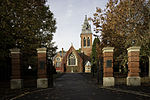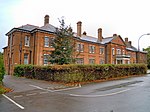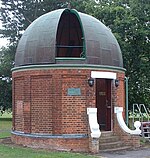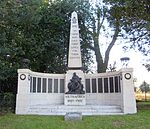Cathedral of St Michael and St George, Aldershot
19th-century Roman Catholic church buildings in the United KingdomCathedrals of military ordinariatesChurches in AldershotGrade II listed Roman Catholic churches in EnglandGrade II listed churches in Hampshire ... and 3 more
Roman Catholic cathedrals in EnglandRoman Catholic churches completed in 1892Roman Catholic churches in Hampshire

Cathedral Church of St Michael and St George serves as the Roman Catholic cathedral for the Bishopric of the Forces. Located on Queens Avenue in Aldershot, England, the building was originally intended to be the principal church for the Anglican chaplaincies of the British Army but since 1973 it has been the seat of the Roman Catholic Bishop of the Forces.
Excerpt from the Wikipedia article Cathedral of St Michael and St George, Aldershot (License: CC BY-SA 3.0, Authors, Images).Cathedral of St Michael and St George, Aldershot
Queen's Avenue, Rushmoor North Town
Geographical coordinates (GPS) Address Nearby Places Show on map
Geographical coordinates (GPS)
| Latitude | Longitude |
|---|---|
| N 51.2599 ° | E -0.7598 ° |
Address
Cathedral Church of St. Michael & St. George (RC)
Queen's Avenue
GU11 2BS Rushmoor, North Town
England, United Kingdom
Open on Google Maps









